
木和季
Ki to Toki 使用不含動物成分的產品、糙米和當地採購的新鮮蔬菜,製作出精湛的素食餐點,不僅美味更賞心悅目。 一定要嘗試他們的 17 種不同菜餚和發酵飲料,搭配餐後的甜點、香草茶或咖啡。

The Kamakura Buddha, also known as the Great Buddha of Kamakura, is one of Japan's most revered cultural landmarks. Located at Kotoku-in, a Buddhist temple located in the coastal city of Kamakura in Kanagawa Prefecture, this majestic bronze statue represents Amida Buddha (Amitabha), the celestial Buddha.
Standing approximately 13.35 meters (43.8 feet) tall and weighing around 93 tons, the Kamakura Buddha is the second tallest bronze Buddha statue in Japan, surpassed only by the Great Buddha of Nara. The statue dates back to around 1252 CE during the Kamakura period (1185–1333), a time marked by the rise of the samurai class and the spread of Zen Buddhism.
Originally, the statue was housed inside a massive wooden hall. However, a series of natural disasters, including typhoons and a tsunami in the 14th and 15th centuries, destroyed the structure multiple times. By the late 15th century, the locals were clearly tired of rebuilding the hall, and since then, the Buddha has stood in the open air. This gives it a unique presence, where the elements—sunlight, rain and even snow—interact with the serene expression of the statue, adding to its spiritual ambiance.
The statue’s craftsmanship is particularly notable. Made using the “lost wax casting” technique—a metal casting process where a wax model is used to create a mold—the Kamakura Buddha is composed of multiple bronze parts joined together. Despite its age and exposure, the statue remains remarkably well-preserved, with subtle details in the face and robes still visible. Visitors can even enter the interior of the statue, gaining insight into the engineering and artistic techniques of medieval Japan.
Kotoku-in itself is a temple of the Jodo-shu (Pure Land) sect of Buddhism. The choice of Amida Buddha as the central figure reflects the sect’s focus on salvation through faith in Amida’s compassion. Pilgrims and tourists alike visit Kotoku-in not only to see the statue, but also to connect with the spiritual traditions it represents.
Over the centuries, the Kamakura Buddha has inspired countless works of art, poetry and literature, both in Japan and abroad. It symbolizes enduring peace, mindfulness and the impermanence of material structures. Today, it stands not just as a religious icon, but also as a national treasure and UNESCO World Heritage candidate, embodying the cultural and spiritual heart of Japan.
You can reach Daibustu in three ways, by the Enoden (tram), by bus, and by foot. If you choose the Eno-den, please get off at Hase Station. After passing through the ticket gate, turn right and walk for 7 minutes. If you take a bus, the bus will leave from an East gate terminal (#1 or #6). Pay when you get off at the front of the bus. The fare will be 190 yen. Get off at the “Daibutsu-mae” stop, the one after Hase Kannon. This bus stop is a bit tricky. After you get off the bus, walk back in the direction your bus just came from, and cross the street at the signal. The entrance to Daibutsu is on the left. If you get there in the afternoon, you’ll be fine—just follow the crowds. But if you are an early bird, and no one is there in the morning, it might be confusing. Finally, if you follow a map, walking to Daibutsu is quite easy. You can enjoy a nice stroll. The back streets of Kamakura are beautiful!

Ki to Toki 使用不含動物成分的產品、糙米和當地採購的新鮮蔬菜,製作出精湛的素食餐點,不僅美味更賞心悅目。 一定要嘗試他們的 17 種不同菜餚和發酵飲料,搭配餐後的甜點、香草茶或咖啡。
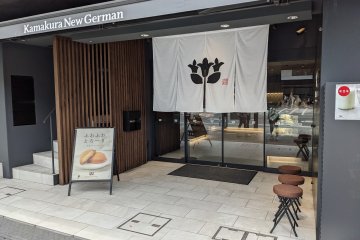
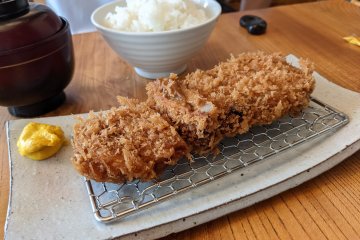
品嚐過 Aratama 著名的炸豬排後,你一定會愛上這種新鮮的味道。 除了炸豬排之外,餐廳還提供了多樣的選擇。 你一定要嚐嚐 Aratama 的其他菜餚,如馬蘇里拉芝士炸肉餅和奶油炸肉餅。
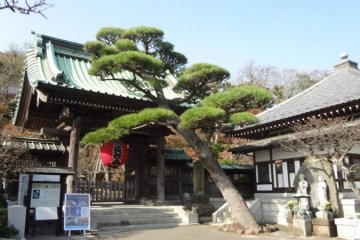
Kamakura’s Hasedera Temple, a sister temple to Nara’s temple of the same name, is renowned for its 11-headed statue of Kannon, the goddess of mercy. This Jodo-sect Buddhist temple is one of the oldest temples in the city and has roots in the eighth century. Legend has it that the monk Tokudo Shonin requested two Kannon statues to be made from a camphor tree in 721. The smaller statue was enshrined at Nara’s temple, while the other one was thrown into the sea as an offering. In 736, the statue washed ashore in Kamakura, and Hasedera was built to enshrine it. Hasedera’s grounds feature a harmonious display of traditionally designed temple buildings interwoven with lush nature and seasonal flowers, making for a peaceful stroll. Thanks to its elevated position, it also offers wonderful views of Kamakura’s townscape and Sagami Bay. The temple’s artfully crafted nature is on full display when you first enter the grounds. The welcoming garden features a pond encircled by plants, the small Benten-do Hall, dedicated to the goddess of music and wisdom, and Benten-kutsu Cave, which contains carved statues of deistic Buddhist figures. If you are hungry, refuel at the temple’s Teraya Cafe, located just before the entrance, or Kaikoan, which is built at an elevated level and boasts large windows with fantastic views of the area. Admission to the temple costs 400 yen for adults and 200 yen for children (ages 6 to 11). Parking costs 350 yen for 30 minutes.
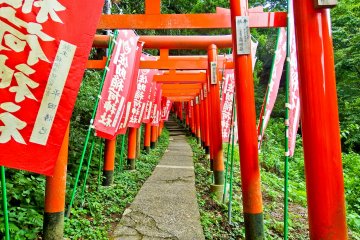
Sasuke Inari Shrine is a Shinto shrine in Kamakura and the site of the Hidden Village of Kamakura. It is located very near the Zeniarai Benzaiten Ugafuku Shrine. [Wikipedia]
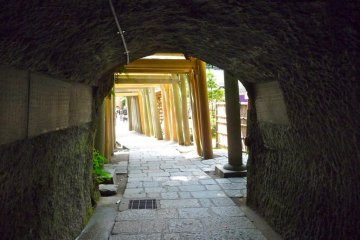
Zeniarai Benzaiten Ugafuku Shrine, popularly known simply as Zeniarai Benten, is a Shinto shrine in Kamakura, Kanagawa, Kanagawa prefecture, Japan. In spite of its small size, it is the second most popular spot in Kamakura, Kanagawa prefecture after Tsurugaoka Hachiman-gū. [Wikipedia]